We have an Impact on Ecosystems, but Not in a Good Way
Ecosystems are biological communities which consist of many organisms interacting in a specific...

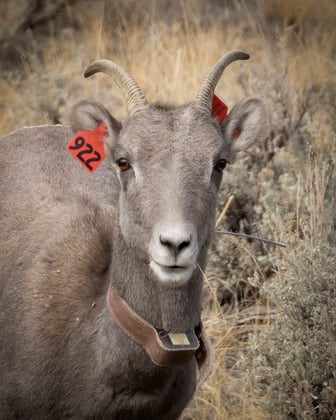
*Text and Photos by Rick Spitzer
Tis the season to give thanks and be mindful of our changing environment as winter approaches. It is important to be sensitive to the needs of our wildlife neighbors as they brave the harsh conditions of Colorado winter. You've likely seen notices of upcoming trail and area closures for hikers, bikers, ATV users, or snowmachines. Have you ever wondered how those decisions are made and why? What is involved in managing wildlife in Eagle County? What can we do as individuals to help wildlife?
The dictionary definition of wildlife management might be "the science and art of managing wildlife and its habitat, for the benefit of the soil, vegetation and animals, including humans."
Many agencies are involved in wildlife management including, Colorado Parks and Wildlife, US Forest Service, Bureau of Land Management, US Fish and Wildlife Service, and the National Park Service. Local agencies in counties, cities, and towns may also be involved. The question might be what do they actually do? What tools do they have to do that work?
In all cases, wildlife managers must base their efforts on quality biological research and information. They need to know about all the species common in the area, what plants these animals use for food and shelter, where they move, and what predators may be in the area that can impact populations. Wildlife management must focus on all the wildlife and all the plants in an environment, not just one species of wildlife.
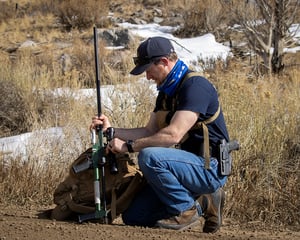
Devin Duval, with Colorado Parks and Wildlife, prepares an air gun that shoots a dart to tranquilize a bighorn for research.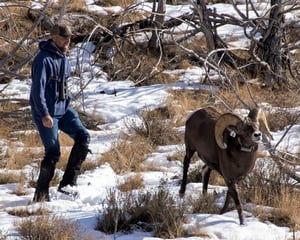
Bryan Lamont, with Colorado Parks and Wildlife, gets a ram moving
after it was fitted with a radio collar and ear tags while anesthetized.
A number of things can be done to determine what wildlife is in an area. Direct observations in the field are a simple way to identify the species. Viewing and counting the animals is a pretty common way to get animal numbers as well as sex and age ratios. Even that may not truly indicate what is actually there and what the populations are.
Public observations may or may not be helpful. Many people are not good observers or have little experience to help with their identification. My experience as a supervisory naturalist in Rocky Mountain National Park made this pretty obvious. I was observing some bighorn sheep at an overlook and a person came up and said "Wow, this is the first time I have ever seen mountain goats!" One morning I was headed to my office and passed some cars parked along the road. People were watching a pair of coyotes hunting rodents in the meadow. About a half hour later a couple came into the visitor center and wanted to report the wolf pack they had just seen in that meadow.
Other first hand observations may include scat and pellet counts, tracks, bedding sites, and damage to trees and bushes in an area.
One strategy that managers can use is trail cams. These cameras can be set up in various locations and the movement or heat signature of the animal triggers the camera and that allows managers to know the species, things about their numbers, and how often they use a specific area. The scene can also be viewed live with some cameras.
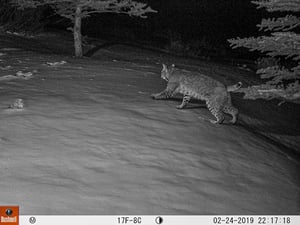
Trail cams can capture photos of wildlife, like this bobcat, that may not normally be seen in an area.
Hair traps can also help identify animals. The traps have small hooks or pins that capture the hair of an animal that moves through or beside it. These traps can be baited to attract the animal. DNA testing of the hair will positively identify the animal.
Aerial counts can also help managers cover a lot of area in a short time. This allows them to locate animals and count them directly. Flying at the same time of day and same time of year over many years will allow managers to determine changes in population and changes in the use of various habitats. This has been done in Eagle County and was used to document the decline in the elk population in the county.
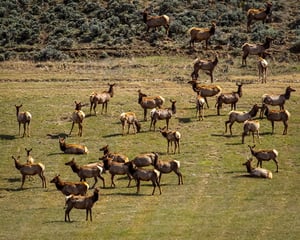
Elk herds can be located and counted using helicopters.

A researcher in a helicopter can photograph and count animals from the air very efficiently
For some research, managers may herd animals into pens, capture them with nets, or tranquilize animals with jab sticks and dart guns. When the animal is down, they record data about size and health, take blood samples, hair, scat, and maybe a tooth for later research. Radio collars, ear tags, and bands are attached to the animals. Ear tags with colors and large numbers allow the animals to be identified with spotting scopes in the field at a later time without having to get very close. Leg bands on birds allow a specific bird to be identified if it should be captured a later time or at another location.
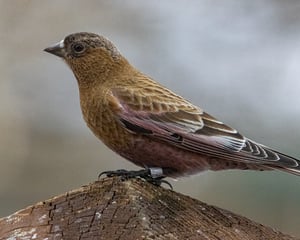
A leg band identifies this specific brown capped rosy finch and allows researchers to identify migration times and routes.
Radio collars allow managers to follow animals over long distances. Some devices can also record activity, heart or respiration rates. In 2009 a radio-collared wolverine was observed and photographed in Rocky Mountain National Park. It had traveled from the Yellowstone ecosystem in northwestern Wyoming around 500 miles into northern Colorado over a period of several months.
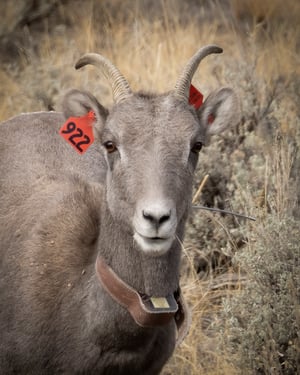
Ear tags and a radio collar will help researchers track the movements of this bighorn ewe.
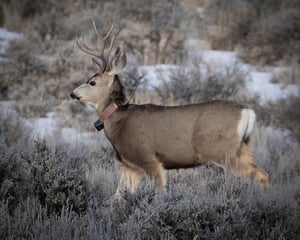
Some radio collars can not only track locations, but provide information about movement times, and activity.
Balancing and conserving all the resources that wildlife needs, including food, water, shelter, and habitat must be known. This must be considered year-round, as wildlife will move through corridors in search of nutrition on a seasonal basis. When any of these factors are compromised, that may limit the kinds of animals, and the animal population. The environment has a carrying capacity, the number of animals that can be supported by that environment. Changing one of the resources may unnaturally increase or decrease the number of animals that can be supported. Wildlife management of an area attempts to keep animals at or just below the carrying capacity.
Many of these factors may be a limiting factor if they are out of balance. Wildlife, like deer and elk, often use the edges of various environments. They may seek shelter and safety in the trees and use the open areas for food. When that is compromised the animals may leave an area or die.
Animal numbers need to be maintained at a level that does not overuse the environmental resources. Failure to do so may impact the population of other animals and can also impact the kind and number of plants in the habitats.
Wildlife management also considers managing the impact humans have on wildlife which is sometimes referred to as social tolerance. For example, if deer or elk damage crops or gardens, it is important to explore ways to mitigate the damage such as fencing or using deterrents that dissuade wildlife from foraging in that area. Homeowners can also plant deer resistant plants as another option.
Other methods that regulate human impacts include the number and type of hunting and fishing licenses for specific areas. One tool used recently in an effort to bend the downward trend and increase our elk population was a reduction in the number of elk cow licenses issued.
It can also result in seasonal or year-round closures in areas needed by wildlife. Damage to the environment or harassment of wildlife in an area may have a huge impact on the local wildlife. The damage might be due to development for houses, roads, and other human needs. It can involve damage to areas along streams and lakes due to camping. Hikers, bikers, ATV owners, and snow machines may interfere with wildlife and cause them to avoid those areas. That may have a drastic impact on populations. Even just a few encounters with humans may impact the ability of wildlife to obtain the nutrition they need or the privacy they require to raise their young.
Wildlife and the habitats they live in have a huge economic impact on the local communities. They provide us with enjoyment when we encounter them in natural environments. Our quality of life is impacted by the wildlife around us. There are times when we must adjust our behavior to protect that wildlife and their habitat.
We all have a responsibility to do what we can to educate ourselves and advocate for the wildlife around us. Failure to understand wildlife needs and not obeying laws and regulations related to wildlife can have a detrimental impact. Wildlife usually does not have the option to go some were else. Those areas may not have food, water, shelter, and certain habitat requirements the animals need. They may enter an area where the carrying capacity is already at the limit and will not support more animals. In other words, they may die.
Whether your winter sports include skiing, fat tire biking, snowshoeing, or enjoying the outdoors while taking your pooch for a walk - please remember your actions make a difference for wildlife. Adhere to trail closures; drive cautiously as wildlife are coming down to the valleys for food and shelter; keep your pooch on a leash and under control at all times. Most wildlife are afraid of dogs and will run away using precious calories, so if the elk are in the dog park, take a different route. If you see wildlife, give them extra space, they need to preserve calories to make it through the winter. You can make a difference, let's help wildlife survive to see next spring.
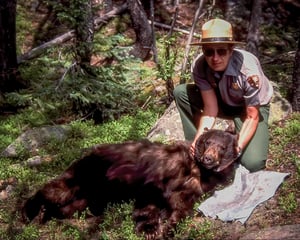 The author with an anesthetized black bear that was captured in a research project in Rocky Mountain National Park.
The author with an anesthetized black bear that was captured in a research project in Rocky Mountain National Park.
The Eagle County Community Wildlife Roundtable is a collaborative partnership with the White River National Forest, Colorado Parks and Wildlife, Bureau of Land Management, local government entities, community members, and citizen scientists. The purpose of the Eagle County Community Wildlife Roundtable is to gather a group of diverse stakeholders in the valley to understand and address issues facing wildlife populations. Together we will identify a shared vision and realistic actions that the community can rally around to support wildlife. We want to leverage diverse values, creativity, and resources to move toward positive action.

Rick Spitzer is the author of the article and official photographer for Eagle County Community Wildlife Roundtable.


Ecosystems are biological communities which consist of many organisms interacting in a specific...
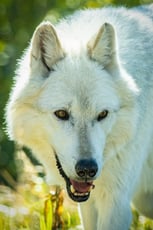

Ecologists have long understood food chains. The animal at the top, the prime predator in an...